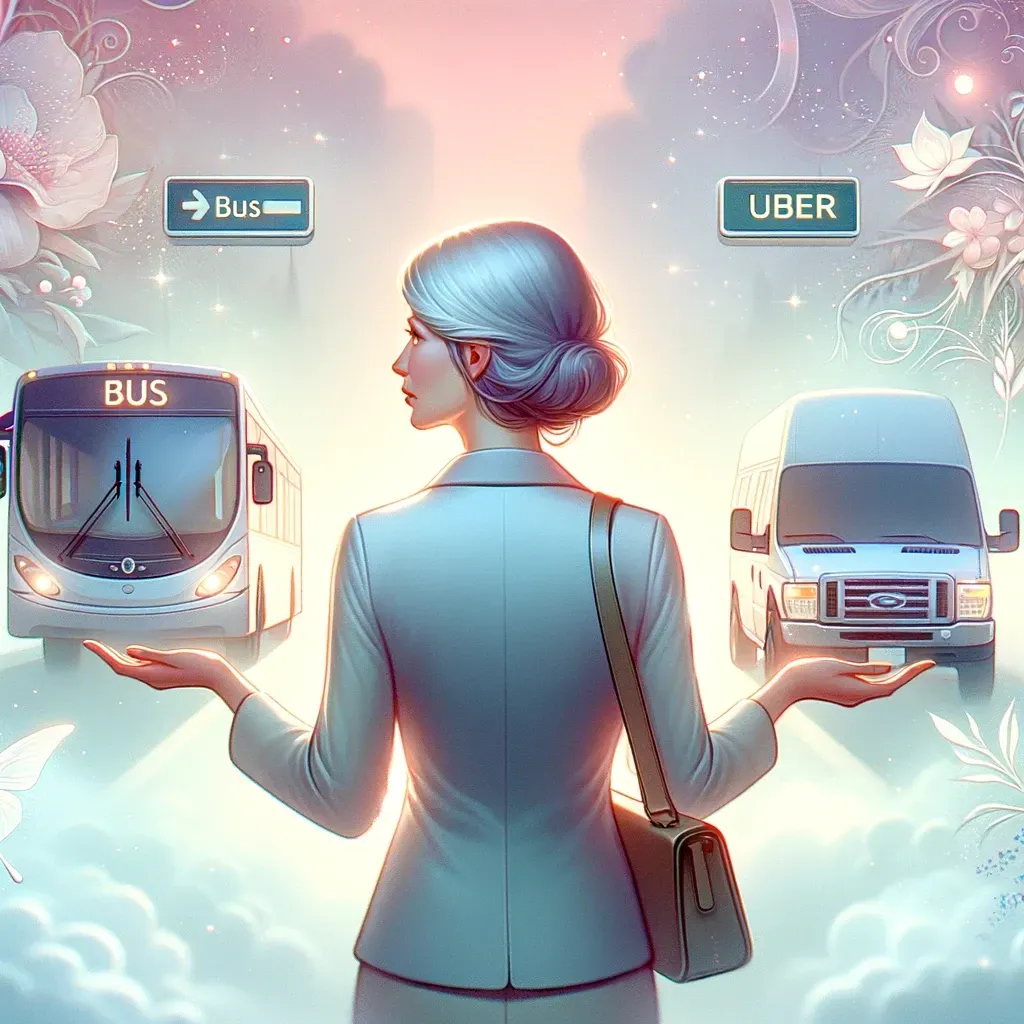INSIDE YOUR FERS BENEFITS

Trading the Bus for Uber: A
“ As Carrie Bradshaw might say, "In the city that never sleeps, why waste your time waiting for the bus when you can Uber your way to a brighter financial future as tax-free as possible?" ~ Melinda Chase
As I sit at my laptop this rainy Friday afternoon, listening to the rain pour down feels like a scene from a classic New York moment – like something out of a "Sex and the City" episode, but in Florida.
I couldn't help but think about my boyfriend's recent transportation adventure here in Tampa. Picture this: twice this week, he might have to get a ride home because of our work schedules.
The bus ride in total is only $4 dollars. Sounds like a bargain, right? But then reality hit us both yesterday, but differently. He spends nearly three hours on this journey, stuck in traffic, making countless stops, and becoming increasingly frustrated, texting me with the delays.
And all I could think was how much easier and faster it would have been if he'd just spent the $20 bucks on the Uber. Sure, it's more money upfront, but think about all that precious time saved and not getting caught in the rain.
I got to thinking, and all of a sudden, I heard Carrie Bradshaw's voice narrating the scene: "In a city where time is money, was saving a few dollars really worth the hassle?"
The answer, in this case, is a resounding no! By the time he finally walked through the door, he looked like a drowned cat because, of course, Florida!
This really got me pondering about financial planning and building wealth. Just like choosing between the bus and an Uber, there are smarter, faster ways to reach your financial goals. It's all about making strategic choices and investing in the right tools as soon as financially possible. Let’s break it down.
The Cost of Time: Breaking Down the Math
Let's break down the math. My boyfriend spends $4 on the bus each trip. If he does this twice a week, costing him 6 hours of his time per week. That's 6 hours a week at $8 per week. Over the course of a month, that's 24 hours for 8 bus rides, totaling $32.
Now, consider the Uber option. Spending $20 per trip, twice a week, costs $40 per week. However, it saves him 5 hours each week. Over a month, this adds up to 20 hours saved, and he spends $160 on 8 Uber rides.
Over 90 days (approximately three months), the numbers look like this:
Bus:
Cost: $96
Time Spent: 72 hours
Uber:
Cost: $480
Time Saved: 54 hours
The difference in cost is $384, but the time saved is 54 hours. Think about what could be done with those extra hours. Learning a new skill, investing time in a side hustle, or even just relaxing and enjoying life.

The Bus Route: The Slow Path to Wealth
Taking the bus, in financial terms, is like doing the bare minimum. You might have a basic savings account or maybe even a traditional 401(k) or think the %5 in the TSP G Fund is sufficient.
These are good starts, but they’re slow and often dependent on factors outside your control – like market fluctuations, employer contributions, and future taxes inside the Traditional IRA or a Traditional Thrift Savings Plan. You’re saving money, sure, but it’s not necessarily the most efficient path.
Just as my boyfriend spent three hours of his life on that bus, you could spend decades slowly accumulating wealth without really maximizing your potential. It's like riding the financial bus – cheap and functional, but painfully slow.
Pros of the Slow and Steady Approach:
Risk Mitigation: By gradually building your retirement savings, you minimize the impact of market volatility. Think of it as buying classic, timeless pieces rather than splurging on every fast-fashion trend.
Security: Cash value insurance policies provide a dual benefit—growth and protection. You're not just saving for retirement; you're also safeguarding against life's "what ifs."
Consistency: Regular, smaller contributions can be more manageable and less daunting, ensuring you stay on track without feeling overwhelmed.
Cons of the Slow and Steady Approach:
Time-Intensive: This method requires patience and discipline. If you're a bit of a Carrie when it comes to instant gratification, waiting for your savings to grow might feel interminable.
Potential for Lower Returns: By playing it safe, you might miss out on higher returns that come with a more balanced or even more aggressive approach.
The Uber Route: The Fast Track to Financial Freedom
Now, let's talk about the financial equivalent of taking an Uber: with the right cash value life insurance plan AND consistent investing in a ROTH 401(k), ROTH TSP, or ROTH IRA, you are utilizing the only 2 places to grow money tax free for your future. These are the smart, strategic moves that can get you to your destination faster and with less taxes.
Pros of the Fast and Furious Approach:
Higher Growth Potential: By investing aggressively early on, you can take advantage of compound interest, which Albert Einstein reportedly called the "eighth wonder of the world."
Front-Loading Savings: Maxing out your tax free retirement accounts early means more time for your investments to grow tax free, leading to a larger nest egg by the time you retire all tax free.
Tax Advantages: Contributing the maximum matched allowable amount, in some financial cases, to tax-advantaged accounts like IRAs and 401(k)s can reduce your taxable income, providing immediate financial benefits today. Be sure to consult your tax professional to make sure you are getting the tax deferred benefits today.
Cons of the Fast and Furious Approach:
Higher Risk: This strategy often involves higher-risk investments, which can lead to greater volatility and potential losses.
Financial Strain: Maxing out contributions might strain your current finances, leaving you with less disposable income for other needs or wants. Know exactly how much you are saving tax deferred and tax free can help you find the right balance year over year as the tax code changes.
The Importance of Regular Benefit Reviews

No matter which path you choose, one thing remains paramount: regular benefit reviews. Just like Carrie and her friends often reassessed their lives, loves, wardrobes and shoes, you should evaluate your retirement strategy regularly.
Why Benefit Reviews are Crucial At Every Stage of Your Federal or Postal Career:
Adapting to Life Changes: Whether it's a job change, a new addition to the family, or unexpected expenses, life is full of surprises. Regular reviews ensure your retirement plan adapts accordingly.
Maximizing Benefits: Understanding your current benefits and how they change over time helps you make informed decisions, ensuring you're not leaving money on the table.
Staying Informed: The world of retirement planning is constantly evolving. Regular reviews keep you updated on new opportunities and strategies.
The Journey to Cash Mastery Begins with Daily Choices
We often undervalue our time when it comes to money. My boyfriend’s three-hour bus ordeal is a perfect metaphor for this. Yes, he saved $16 each week, but at what cost? Time is our most precious resource, and once it's gone, we can never get it back. By spending a little more on an Uber, he could have arrived home relaxed and with time to spare.
The same principle applies to financial planning. Investing a little more time and money now in the right financial strategy can save you years of stress and uncertainty down the road. It’s about valuing your time and making choices that align with your long-term goals and what's affordable for where you are right now to start.
Making the Smart Choice
Just like my boyfriend eventually saw the value in spending a bit more for a quicker, more comfortable ride, it’s crucial for us to see the value in investing wisely. Don’t settle for the financial bus when you can Uber your way to wealth and security.
In the end, it’s about making the smart choice – one that prioritizes your time, your budget, and your ultimate future. So, the next time you find yourself weighing the cost of an Uber versus a bus, think about your financial journey. Are you taking the slow, scenic route, or are you ready to invest in a faster, more efficient path to wealth?
As Carrie Bradshaw might say, “In the city that never sleeps, why waste your time waiting for the bus when you can Uber your way to a brighter financial future as tax-free as possible?”
Remember, the choice is yours. Let’s make it a smart one. Just Call Melinda – because your financial journey deserves the best ride (and shoes!) possible.

